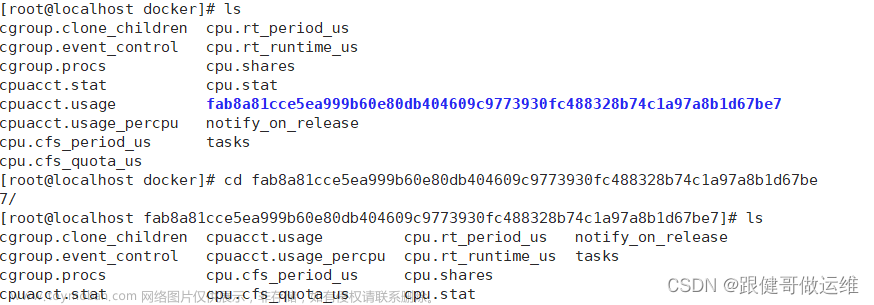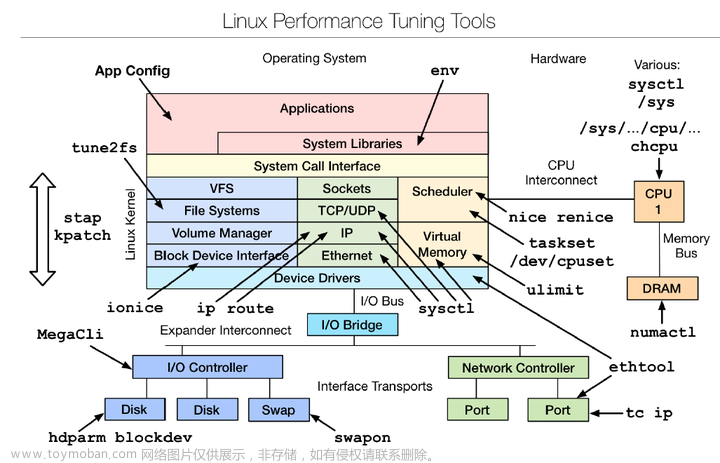目录
编辑
1.限制容器对内存的使用
2.限制容器对CPU的使用
3.block IO权重
4.实现容器的底层技术
1.cgroup
1.查看容器的ID
2.在文件中查找
2.namespace
1.Mount
2.UTS
3.IPC
4.PID
5.Network
6.User
1.限制容器对内存的使用
⼀个 docker host 上会运⾏若⼲容器,每个容器都需要 CPU、内存和 IO 资源。对于 KVM,VMware 等虚拟化技 术,⽤户可以控制分配多少 CPU、内存资源给每个虚拟机。对于容器,Docker 也提供了类似的机制避免某个容器 因占⽤太多资源⽽影响其他容器乃⾄整个 host 的性能。
内存限额 与操作系统类似,容器可使⽤的内存包括两部分:物理内存和 swap。 Docker 通过下⾯两组参数来控制容器内存 的使⽤量。
-m 或者--memory:设置内存的使用限额,例如100M,2G。
--memory-swap:设置内存+swap的使用限额。当我们执行如下命令:
[root@localhost ~]# docker run -it -m 200M --memory-swap=300M centos:7其含义是允许该容器最多使⽤ 200M 的内存和 100M 的 swap。默认情况下,上⾯两组参数为 -1,即对容器内存 和 swap 的使⽤没有限制。
下⾯我们将使⽤ progrium/stress 镜像来学习如何为容器分配内存。该镜像可⽤于对容器执⾏压⼒测试。执⾏如下 命令:
[root@localhost ~]# docker run -it -m 200M --memory-swap=300M progrium/stress --vm 1 --vm-bytes 280M
选项:
--vm 1:启动 1 个内存⼯作线程
--vm-bytes 280M:每个线程分配 280M 内存因为299M在可分配的范围内,所以工作线程能够正常工作,过程是:
[root@localhost ~]# docker run -it -m 200M --memory-swap=300M progrium/stress --vm 1 --vm-bytes 299M
stress: info: [1] dispatching hogs: 0 cpu, 0 io, 1 vm, 0 hdd
stress: dbug: [1] using backoff sleep of 3000us
stress: dbug: [1] --> hogvm worker 1 [8] forked
stress: dbug: [8] allocating 313524224 bytes ...
stress: dbug: [8] touching bytes in strides of 4096 bytes ...
stress: dbug: [8] freed 313524224 bytes
stress: dbug: [8] allocating 313524224 bytes ...
stress: dbug: [8] touching bytes in strides of 4096 bytes ...
stress: dbug: [8] freed 313524224 bytes
stress: dbug: [8] allocating 313524224 bytes ...-
分配299内存
-
释放299内存
-
再分配299内存
-
再释放299内存
-
一直循环
如果让工作线程分配的内存超过300M,结果如下:
[root@localhost ~]# docker run -it -m 200M --memory-swap=300M progrium/stress --vm 1 --vm-bytes 301M
stress: info: [1] dispatching hogs: 0 cpu, 0 io, 1 vm, 0 hdd
stress: dbug: [1] using backoff sleep of 3000us
stress: dbug: [1] --> hogvm worker 1 [7] forked
stress: dbug: [7] allocating 315621376 bytes ...
stress: dbug: [7] touching bytes in strides of 4096 bytes ...
stress: FAIL: [1] (416) <-- worker 7 got signal 9
stress: WARN: [1] (418) now reaping child worker processes
stress: FAIL: [1] (422) kill error: No such process
stress: FAIL: [1] (452) failed run completed in 0s注意:分配的内存超过限额,stress线程报错,容器退出。
如果在启动容器时只指定 -m ⽽不指定 --memory-swap,那么 --memory-swap 默认为 -m 的两倍,⽐如:
docker run -it -m 200M centos容器最多使⽤ 200M 物理内存和 200M swap。
2.限制容器对CPU的使用
默认设置下,所有容器可以平等地使⽤ host CPU 资源并且没有限制。 Docker 可以通过 -c 或 --cpu-shares 设置容器使⽤ CPU 的权重。如果不指定,默认值为 1024。 与内存限额不同,通过 -c 设置的 cpu share 并不是 CPU 资源的绝对数量,⽽是⼀个相对的权重值。某个容器最终 能分配到的 CPU 资源取决于它的 cpu share 占所有容器 cpu share 总和的⽐例。
换句话说:通过 cpu share 可以设置容器使⽤ CPU 的优先级。
⽐如在 host 中启动了两个容器:
[root@localhost ~]# docker run --name 'centos-1' -c 1024 --cpu 1 centos:7
[root@localhost ~]# docker run --name 'centos-2' -c 512 --cpu 1 centos:7
选项:
-c:CPU权重
--cpu:CPU核数centos-1 的 cpu share 1024,是centos-2的两倍。当两个容器都需要 CPU 资源时,centos-1 可以得 到的 CPU 是 centos-2 的两倍。
需要特别注意的是,这种按权重分配 CPU 只会发⽣在 CPU 资源紧张的情况下。如果centos-1 处于空闲状态, 这时,为了充分利⽤ CPU 资源,centos-2 也可以分配到全部可⽤的 CPU。
例子:
启动 container_A,cpu share 为 1024:
[root@localhost ~]# docker run --name container_A -it -c 1024 progrium/stress --cpu 4
stress: info: [1] dispatching hogs: 4 cpu, 0 io, 0 vm, 0 hdd
stress: dbug: [1] using backoff sleep of 12000us
stress: dbug: [1] --> hogcpu worker 4 [7] forked
stress: dbug: [1] using backoff sleep of 9000us
stress: dbug: [1] --> hogcpu worker 3 [8] forked
stress: dbug: [1] using backoff sleep of 6000us
stress: dbug: [1] --> hogcpu worker 2 [9] forked
stress: dbug: [1] using backoff sleep of 3000us
stress: dbug: [1] --> hogcpu worker 1 [10] forked--cpu ⽤来设置⼯作线程的数量。因为当前 host 只有 1 颗 CPU,所以⼀个⼯作线程就能将 CPU 压满。如果 host 有多颗 CPU,则需要相应增加 --cpu 的数量。
启动 container_B,cpu share 为 512:
[root@localhost ~]# docker run --name container_B -it -c 512 progrium/stress --cpu 4
stress: info: [1] dispatching hogs: 1 cpu, 0 io, 0 vm, 0 hdd
stress: dbug: [1] using backoff sleep of 3000us
stress: dbug: [1] --> hogcpu worker 1 [7] forked在 host 中执⾏ top,查看容器对 CPU 的使⽤情况:
[root@localhost ~]# top
top - 22:22:11 up 55 min, 4 users, load average: 5.49, 2.17, 0.84
Tasks: 147 total, 9 running, 138 sleeping, 0 stopped, 0 zombie
%Cpu(s): 99.8 us, 0.2 sy, 0.0 ni, 0.0 id, 0.0 wa, 0.0 hi, 0.0 si, 0.0 st
KiB Mem : 3865552 total, 2876864 free, 279432 used, 709256 buff/cache
KiB Swap: 2097148 total, 2095436 free, 1712 used. 3284060 avail Mem
PID USER PR NI VIRT RES SHR S %CPU %MEM TIME+ COMMAND
11431 root 20 0 7308 96 0 R 66.4 0.0 1:59.51 stress
11433 root 20 0 7308 96 0 R 66.4 0.0 2:00.93 stress
11434 root 20 0 7308 96 0 R 66.4 0.0 1:57.31 stress
11432 root 20 0 7308 96 0 R 66.1 0.0 2:00.42 stress
12343 root 20 0 7308 96 0 R 33.6 0.0 0:05.46 stress
12342 root 20 0 7308 96 0 R 33.2 0.0 0:05.40 stress
12344 root 20 0 7308 96 0 R 33.2 0.0 0:05.48 stress
12341 root 20 0 7308 96 0 R 32.9 0.0 0:05.40 stress现在挂起container_A
[root@localhost ~]# docker pause container_A
container_Atop 显示 container_B 在 container_A 空闲的情况下能够⽤满整颗 CPU
3.block IO权重
默认情况下,所有容器能平等地读写磁盘,可以通过设置 --blkio-weight 参数来改变容器 block IO 的优先级。
--blkio-weight 与 --cpu-shares 类似,设置的是相对权重值,默认为 500。在下⾯的例⼦中,container_A 读写磁 盘的带宽是 container_B 的两倍。
[root@localhost ~]# docker run -it --name container_A --blkio-weight 600 centos
[root@localhost ~]# docker run -it --name container_B --blkio-weight 300 centos限制 bps 和 iops
-
bps 是 byte per second,每秒读写的数据量。
-
iops 是 io per second,每秒 IO 的次数。
可通过以下参数控制容器的 bps 和 iops:
-
--device-read-bps,限制读某个设备的 bps。
-
--device-write-bps,限制写某个设备的 bps。
-
--device-read-iops,限制读某个设备的 iops。
-
--device-write-iops,限制写某个设备的 iops。
例子:限制容器写/dev/sda的速率为30MB/s
[root@localhost ~]# docker run -it --device-write-bps /dev/sda:30MB centos:7
[root@85ec78d68f3d /]# dd if=/dev/zero of=1.txt bs=1M count=300
300+0 records in
300+0 records out
314572800 bytes (315 MB) copied, 0.116481 s, 2.7 GB/s
[root@85ec78d68f3d /]# dd if=/dev/zero of=1.txt bs=1M count=300 oflag=direct
300+0 records in
300+0 records out
314572800 bytes (315 MB) copied, 9.91958 s, 31.7 MB/s通过 dd 测试在容器中写磁盘的速度。因为容器的⽂件系统是在 host /dev/sda 上的,在容器中写⽂件相当于对 host /dev/sda 进⾏写操作。另外,oflag=direct 指定⽤ direct IO ⽅式写⽂件,这样 --device-write-bps 才能⽣ 效。
4.实现容器的底层技术
为了更好地理解容器的特性,本节我们将讨论容器的底层实现技术。
cgroup 和 namespace 是最重要的两种技术。cgroup 实现资源限额, namespace 实现资源隔离。
1.cgroup
cgroup 全称 Control Group。Linux 操作系统通过 cgroup 可以设置进程使⽤ CPU、内存 和 IO 资源的限额。-- cpu-shares、-m、--device-write-bps 实际上就是在配置 cgroup。
cgroup 到底⻓什么样⼦呢?我们可以在 /sys/fs/cgroup 中找到它。还是⽤例⼦来说明,启动⼀个容器,设置 -- cpu-shares=512:
1.查看容器的ID
[root@localhost ~]# docker ps -a --no-trunc
CONTAINER ID IMAGE COMMAND CREATED STATUS PORTS NAMES
85ec78d68f3d9daa9b5604845c18364760c5f1be506098e6cac81717eb0e3e69 centos:7 "/bin/bash" 5 minutes ago Exited (127) 19 seconds ago youthful_merkle2.在文件中查找
在 /sys/fs/cgroup/cpu/docker ⽬录中,Linux 会为每个容器创建⼀个 cgroup ⽬录,以容器⻓ID 命名:
[root@localhost ~]# ls /sys/fs/cgroup/cpu/docker/414090cec75558162c3679b913af2c739b44bd6228f8184662e7a2e253f12a69/
cgroup.clone_children cpuacct.stat cpu.cfs_period_us cpu.rt_runtime_us notify_on_release
cgroup.event_control cpuacct.usage cpu.cfs_quota_us cpu.shares tasks
cgroup.procs cpuacct.usage_percpu cpu.rt_period_us cpu.stat⽬录中包含所有与 cpu 相关的 cgroup 配置,⽂件 cpu.shares 保存的就是 --cpu-shares 的配置,值为 512。 同样的,/sys/fs/cgroup/memory/docker 和 /sys/fs/cgroup/blkio/docker 中保存的是内存以及 Block IO 的 cgroup 配置。
2.namespace
在每个容器中,我们都可以看到⽂件系统,⽹卡等资源,这些资源看上去是容器⾃⼰的。拿⽹卡来说,每个容器都 会认为⾃⼰有⼀块独⽴的⽹卡,即使 host 上只有⼀块物理⽹卡。这种⽅式⾮常好,它使得容器更像⼀个独⽴的计 算机。
Linux 实现这种⽅式的技术是 namespace。namespace 管理着 host 中全局唯⼀的资源,并可以让每个容器都觉 得只有⾃⼰在使⽤它。换句话说,namespace 实现了容器间资源的隔离。
Linux 使⽤了六种 namespace,分别对应六种资源:Mount、UTS、IPC、PID、Network 和 User,下⾯我们分 别讨论。
1.Mount
Mount namespace 让容器看上去拥有整个⽂件系统。
容器有⾃⼰的 / ⽬录,可以执⾏ mount 和 umount 命令。当然我们知道这些操作只在当前容器中⽣效,不会影响 到 host 和其他容器。
2.UTS
简单的说,UTS namespace 让容器有⾃⼰的 hostname。 默认情况下,容器的 hostname 是它的短ID,可以通 过 -h 或 --hostname 参数设置。
[root@localhost ~]# docker run -it -h test1 centos:7
[root@test1 /]#3.IPC
IPC namespace 让容器拥有⾃⼰的共享内存和信号量(semaphore)来实现进程间通信,⽽不会与 host 和其他 容器的 IPC 混在⼀起。
4.PID
我们前⾯提到过,容器在 host 中以进程的形式运⾏。例如当前 host 中运⾏了两个容器:
[root@localhost ~]# docker inspect centos-2 -f '{{.State.Pid}}'
14300
[root@localhost ~]# docker inspect youthful_merkle -f '{{.State.Pid}}'
14568⽽且进程的 PID 不同于 host 中对应进程的 PID,容器中 PID=1 的进程当然也不是 host 的 init 进程。也就是说: 容器拥有⾃⼰独⽴的⼀套 PID,这就是 PID namespace 提供的功能。
5.Network
Network namespace 让容器拥有⾃⼰独⽴的⽹卡、IP、路由等资源文章来源:https://www.toymoban.com/news/detail-619596.html
6.User
User namespace 让容器能够管理⾃⼰的⽤户,host 不能看到容器中创建的⽤户。文章来源地址https://www.toymoban.com/news/detail-619596.html
到了这里,关于【云原生】Docker容器资源限制(CPU/内存/磁盘)的文章就介绍完了。如果您还想了解更多内容,请在右上角搜索TOY模板网以前的文章或继续浏览下面的相关文章,希望大家以后多多支持TOY模板网!










